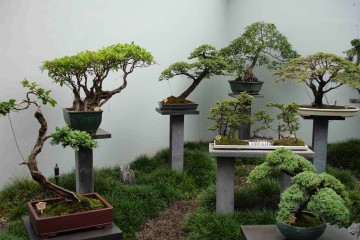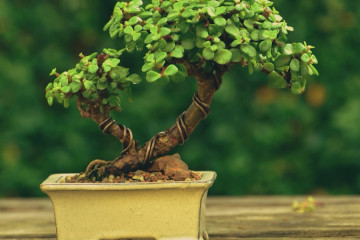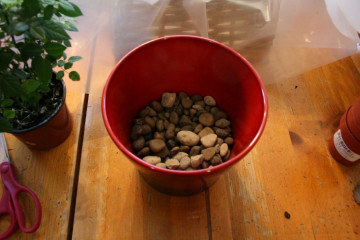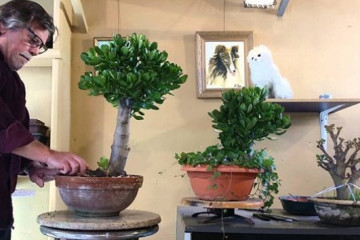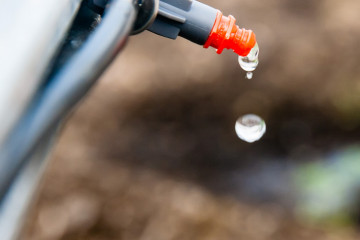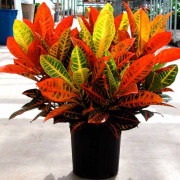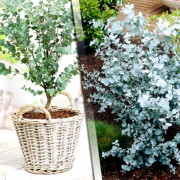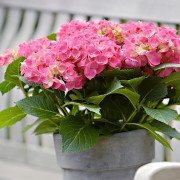Supports for apple trees - how to do it yourself
Content:
The most active vegetation of plants falls on the summer period. Therefore, it is necessary not only to carry out regular watering and pest control, but also to provide physical support to trees and shrubs. In order for the branches to support the weight of the fruit, it is necessary to organize supports for them. How to tie up an apple tree so that the branches do not break off is the main question for any gardener.
Why prop up an apple tree
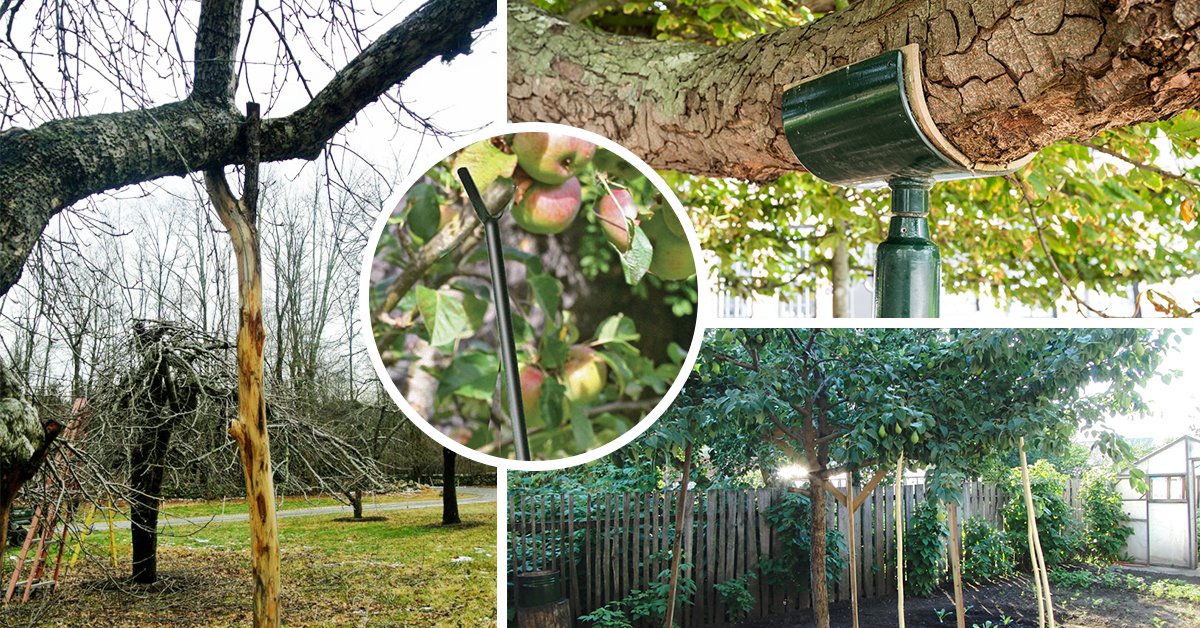
Supports protect the integrity of the tree and help preserve the crop
A mature apple tree has spreading branches and bears fruit abundantly. At the end of summer, when apples are poured, the tree has a particularly difficult time - the weight of the fruit becomes maximum and the branches stretch downward. They can crack and break under severe stress. In this case, the plant needs external help, namely chatalovka or the installation of a strong support for the crown. Thus, the supporting mechanism provides:
- Preservation of the available crop.
- Long life to the main branches, as well as young branches in the process of active vegetation.
- The integrity and stability of the apple tree trunk.
- Substantial support for growing seedlings.
Types of props for apple trees with your own hands
Supports for apple trees are made from almost any available materials - boards and sticks, rods and pipes. The following design options are most common.
Stand with a spear
The simplest do-it-yourself apple tree supports are made in the form of a spear - a long stick with a forked end. Important in this design is the angular distance between the teeth of the slingshot. So, too small a Y-shaped angle will squeeze the branch, interfering with its nutrition and growth. Rogatina can be found in the forest area or crafted in person. In the second option, you need to take a long and fairly thick wooden board (stick), nail another workpiece perpendicularly to it - you should get a structure resembling the letter T. The top of the product is leveled and wrapped with cloth to create additional comfort for the apple tree. The lower end is stuck into the ground, it is better to sharpen it first.
The advantages of this support:
- Can be crafted quickly.
- It is easy to substitute to the desired part of the apple tree and remove when winter comes.
Disadvantages:
- Precariousness: Gusts of wind or careless movements can drop it. Often, gardeners use 2-3 additional poles to anchor the main part.
- The fragility of wooden products. To extend their service life, it is necessary to cover the support with a moisture-proof solution.
Umbrella chatal
Required materials and tools:
- Long stick of high strength.
- Thick rubber (for example, from a hose or tire).
- Steel wire (rope).
- Metal ring.
- Knife (hacksaw).
- Stairs.
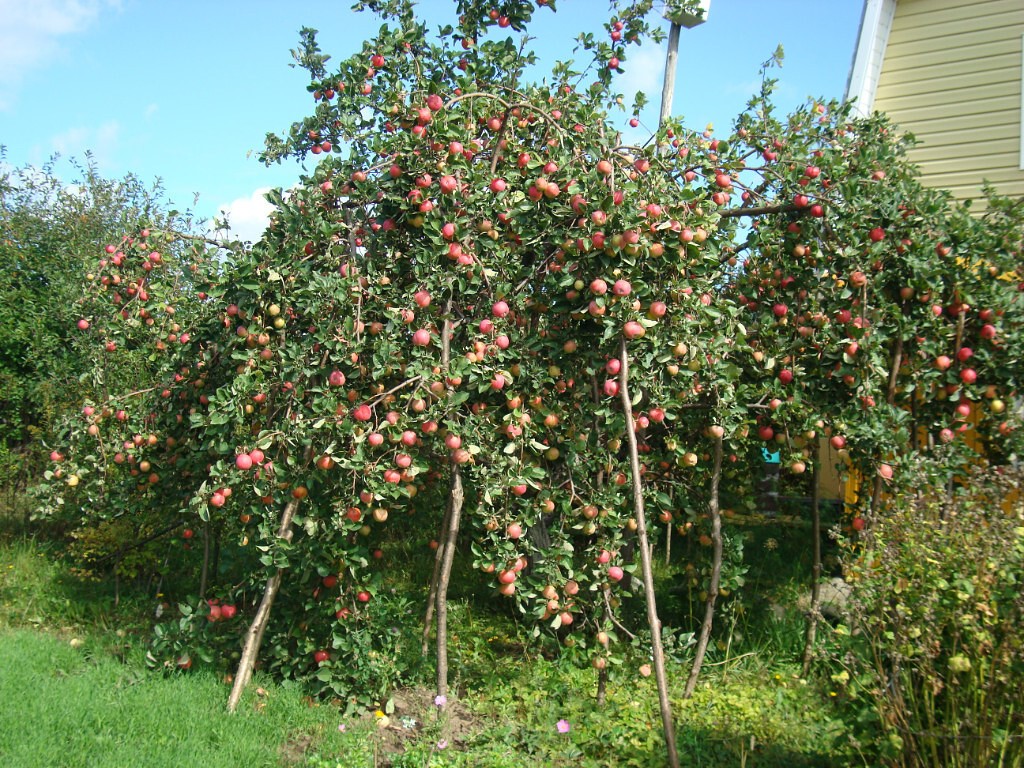
Tree supports vary in appearance and design
Initially, a pillar is set slightly higher than the plant; it is dug into the ground next to the apple tree. Wire threads are attached to the pole, and rubber clamps must be tied to them - a kind of lining for the bark.Clamps are wound under the shoots and attached to the main structure by means of rings. Accordingly, the number of garters should be equal to the number of branches that need support.
Advantages of such a "carousel":
- Plant safety.
- Reliability of construction and durability: it is not necessary to remove the umbrella chattel in case of frost.
- Protection of branches not only from the fruit load, but also from bad weather - winds and snowfall.
Of the shortcomings, only the length of the manufacturing process and the need for additional help from a partner can be noted.
Ladder supports
The bookcase or staircase consists of wooden posts installed in the shape of an L symbol at a distance of 0.5 meters from the base of the apple tree. Planks are horizontally located between the sticks, which hold them together. The ends of these stakes are driven into the ground by 10-12 cm, while the branches can be supported with a soft wire. Sometimes the design is complicated by additional poles that are brought in from different sides of the tree.
With such a ladder system, you can strengthen the overgrown branches of a mature plant, as well as fence off a young apple tree. The stepladder is usually used temporarily, it is placed under congested areas, and it folds easily. It can also act as a stand when picking apples.
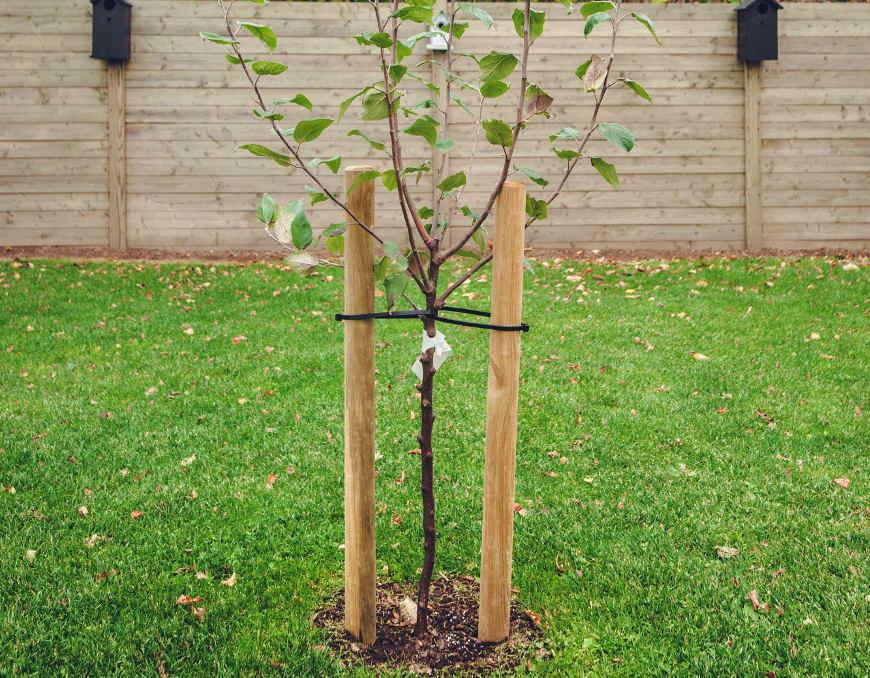
Individual support can be made for each seedling separately
Telescopic support
For telescopic support, plastic tubes of various diameters are usually used. They are inserted into each other, holes are made in them about a centimeter in diameter to adjust the height of the apple support. Then bolts are placed in the punctures, fixed there. You also need to purchase plastic panels, warm them up a little and bend them manually in the form of a C mark. These plates are fixed at the ends of the tubes from the outside. It is recommended to glue the inside with a soft cloth.
In another embodiment, a hollow profile is used to make a device of this kind. Dural tubes are connected to one another according to the pattern of a nesting doll: a small one (a half-inch hole) is inserted into a large one about an inch in diameter, the latter has steel hooks at the end. To obtain a support of the desired length, the profile tubes are moved apart and fixed using wedges driven into the prepared holes.
T-shaped support
The next type of supports is similar to a spear - they need to be made by connecting 2 boards so that the letter T is obtained. After that, the support is placed in the right place near the apple tree under the heaviest branch. In this case, the rod is located vertically, the base is buried in the ground, and the branch is fixed on the upper horizontal axis.
If there is an abundance of apples and one stick is clearly not enough to support the apple tree, put another 2-3 structures. This creates the strongest pyramid supports with 4 corners. The device is made of 2 wooden trapezoids, placed on opposite sides from each other. Approximately the same distance is left between the lower ends of the frames, the upper edges must be tilted towards the center. All parts of the pyramid are securely fixed.
Metal supports for apple trees
Metal supports can be of any shape indicated in the article. Metal elements may be supplemented with plastic or wooden elements. So, if you choose a telescopic support, then you can use tubes of different sizes. The process of their installation is quite simple: a hole is drilled at the ends of the parts, a thin pipe is inserted into a wide one, the structure is fixed with a screw or nail. You need to attach a rubber gasket on top. The support is first placed on the high branches, then on those that are located below.
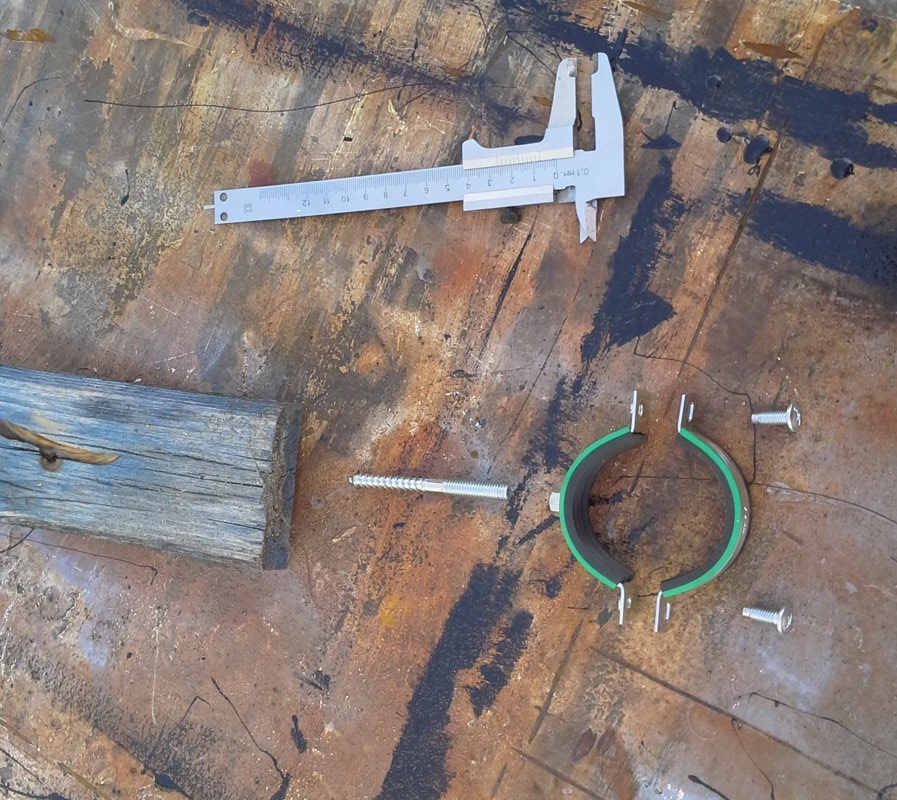
Supports can be made by hand and installed without the help of specialists.
Device advantages:
- Ability to support large and heavily loaded branches.
- The support will be able to withstand all weather conditions, but will rust over time in high humidity.
Disadvantages:
- Quality metal is usually expensive.
How to strengthen branches from splits
Experts do not advise waiting for the critical moment when the branches are already beginning to break off in order to start tying. It is necessary to protect them from splitting in advance.
Split protection rings
To prevent the twigs from cracking and eventually breaking off, the most vulnerable areas are closed in special rings. They are made of iron or steel and tightened with screws and bolts. From the inside, the hoop is pasted over with a soft cloth, covered with a tourniquet, and then screwed to the trunk of the tree. Branches are strengthened in this way in early spring, until the buds have blossomed.
Arc support for branches
The arch supports for the crown are made of rubber, for example, from tires for tractors or a camera for a bicycle, depending on the size and weight of the branches. Cut them into pieces with a hacksaw and apply them to the branches. Holes are made in the material with a sharp nail and a high strength arcuate wire is inserted. The arc angle is between 35-55 degrees.
Trellis and ring or rim
The tapestry is traditionally used for dwarf apple varieties. The structure is made of wire, which is fixed with its ends to posts or a metal device. To secure the branches to the trellis, use twine, plastic fasteners or a ready-made bicycle rim. If the tree has grown a lot, it is additionally required to make an iron ring with 5 internal spokes. The hoop is attached to 4 poles that can be made from tubes. The posts are wrapped with household cloth, agrofibre.
Tying a plant to a lattice is very beneficial, as this solves many difficulties:
- Does not allow thickening of the crown.
- Supports shoots and branches, thereby eliminating fragility and splitting of areas.
- Increases the endurance of branches to various weather conditions, as well as rather heavy rains and winds in summer.
- It has a positive effect on the quantity and quality of apples.
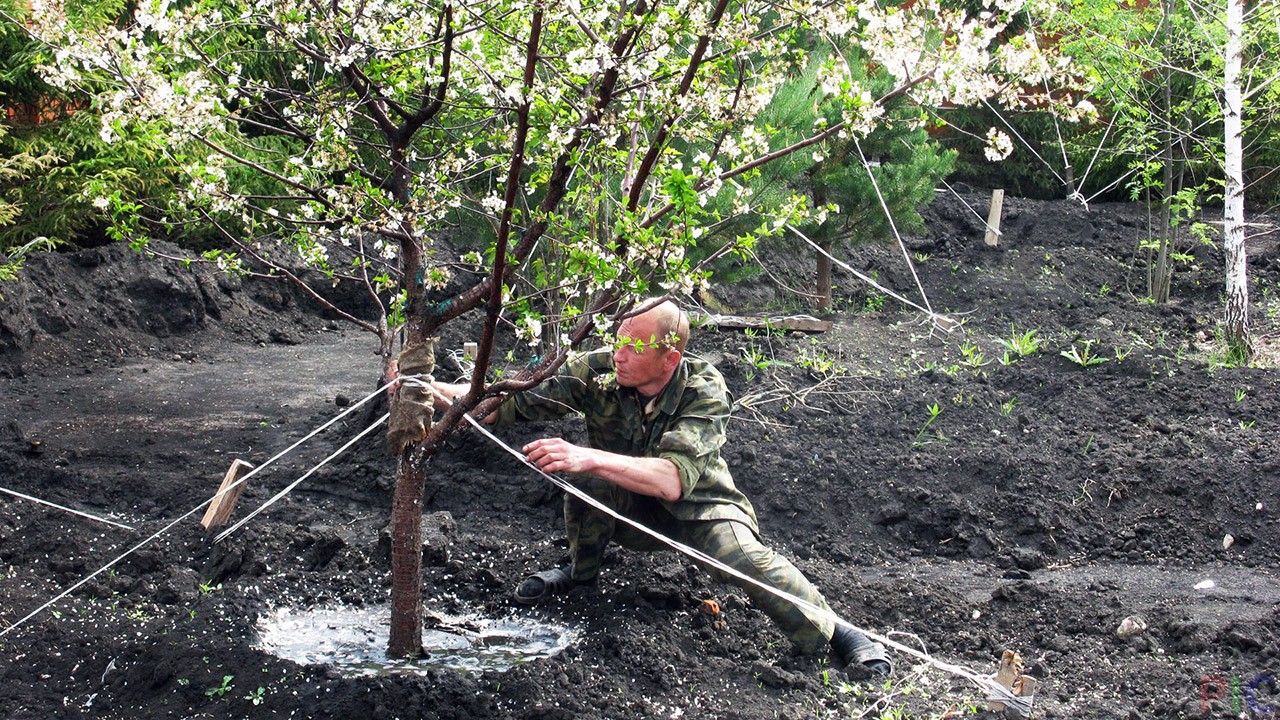
Garters or supports are used both for the trunk of the tree and separately for the branches
How to lift a fallen apple tree
Gardeners may have not only the task of supporting the branches of an apple tree with apples, but also the problem of lifting an already fallen tree. This is a fairly common occurrence after severe bad weather. Before you take active steps to raise the tree, you need to consider a number of factors:
- The age of the apple tree: could it break not only due to weather conditions, but also due to old age.
- The place of the break: how much the barrel was damaged, in what condition the bole was.
- Fruit ripeness: are there still many green apples on the branches and is it possible to leave the tree in its current position so that the fruits ripen.
- The period of limitation of the fall of the plant.
Young trees have more prospects for recovery. If the planting is only partially broken, there is a high chance of preserving the crop. It is imperative to collect the apples and prop up the leaning plant. A more difficult case, when the apple tree fell completely and the roots were pulled out of the soil. Then the owner needs to:
- Lift the tree and tie or put on a support. How to tie up an apple tree is described above.
- Next, assess the condition of the trunk and root part: fill the pulled out areas to the top with fertilized soil.
- Place a fence around the area to protect it from animals and rain.
- Water the problem area of the apple tree regularly, feed abundantly.You can use fertilizers that are usually selected for feeding the seedlings.
- If the result is positive, the tree began to actively grow, the apple tree remains in its current, more horizontal position.
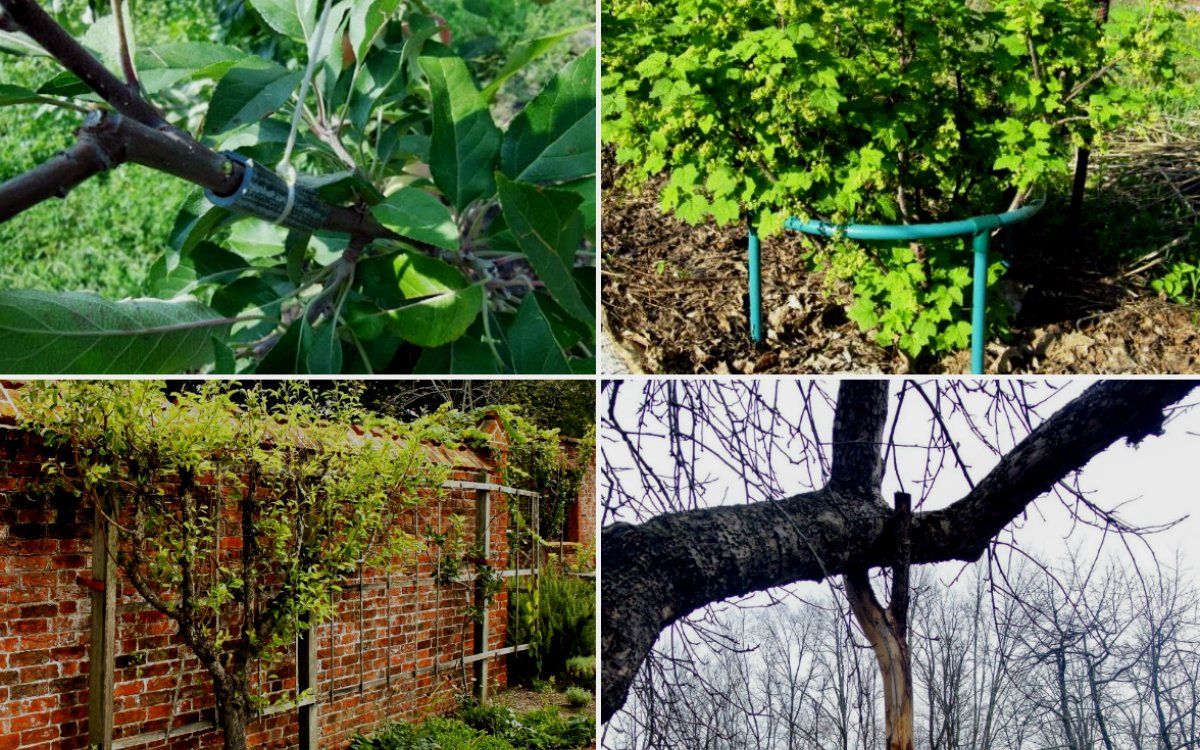
With the help of supports, you can support the tree, as well as raise it if it breaks
You can save the plant, provided that it began to tilt and eventually broke not so long ago. Unfortunately, in a different situation, for example, if an incident happened some time ago or more than half of the diameter of the trunk was initially damaged, the described actions will have no effect. Apples can no longer be saved, but you can try to restore the tree in the following way:
- Cut off the fallen off part.
- Cover the wounds with red lead from drying oil.
- Take remedial measures to revitalize the remaining intact branches.
Many negative environmental factors affect the condition of the garden and, directly, the harvest. Supports are used quite often for most fruit plants - apple trees, pears, plums, grapes, etc. The owner of the garden can choose a frame of a certain shape and size, suitable for the size of a particular tree and make it himself from the available materials.
